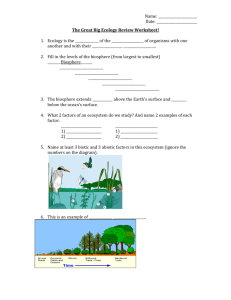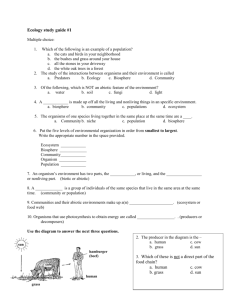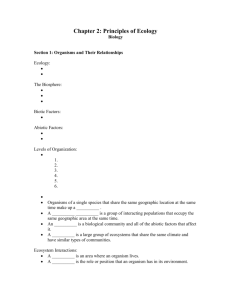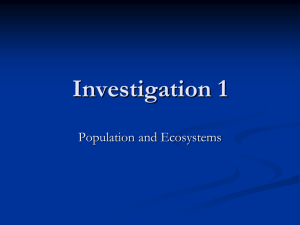Ecology:
advertisement
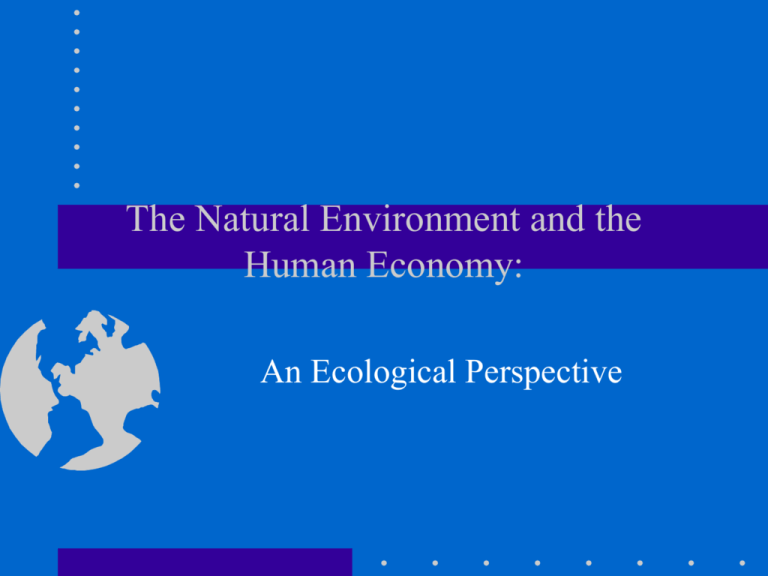
The Natural Environment and the Human Economy: An Ecological Perspective The Biosphere and Human Economy – The following are key elements of the basic principles governing the nature, structure and function of the biosphere (hence, environmental resources) and the functional linkages (relationships) between the biosphere and the human economy: continue… Environmental resources or the biosphere is finite. Hence, environmental resources are scarce in absolute terms. • In nature, everything is related to everything else. Moreover, survival of the biosphere requires recognition of the mutual interdependencies among all the elements that constitute the biosphere continue… • At a functional level and from a purely physical viewpoint, the biosphere is characterized by a continuous transformation of matter and energy. Furthermore, the transformation of matter and energy are governed by some immutable natural laws. • Material recycling is essential for the growth and revitalization of all the subsystems of the biosphere, including the human economy. continue… • Granted that nothing remains constant in nature. Furthermore, changes in ecosystems do not appear to occur in an absolutely linear and predictable manner. However, measured in a geological time scale, the natural tendency of an ecological community (species of plants, animals and microorganisms living together) tends to be to progress from simple and unstable relationships (pioneer stage) to a more stable, resilient, diverse and complex community. continue… The human economy is a subsystem of the biosphere and it would be dangerously misleading to view natural resources as just factors of production lying outside the confines of the larger system. The natural disposition of the technological human has tended towards the simplification of the natural systems eventually leading toward less stable, resilient, and diverse ecological communities. What is Ecology? • Ecology is a branch of science that systematically studies the relationships between living organisms and the physical and chemical environment in which they live. Why Study Ecology? to provide a broader and deeper understanding of the natural process by which natural resources are created and maintained; to understand some of the natural laws that impose limitations on the interaction of organisms (including humans) with their living and nonliving environment; continue… • to show the specific ways in which human interaction with nature has been incompatible, and to identify some of the important links between ecology and economics, two disciplines which are imperative for a holistic view of natural resource problems and issues. ECOSYSTEM: A Starting Point of Ecological Study • An ecosystem includes living organisms in a specified physical environment, the multitude of interactions between the organisms, and the non-biological factors in the physical environment that limit their growth and reproduction, such as air, water, minerals, and temperature. continue... • Major components of an ecosystem: – Abiotic (nonliving) components • The atmosphere (air) • The hydrosphere (water) • The lithosphere (earth crust) – Biotic (living) component • Producers -- organisms capable of photosynthesis • Consumers -- herbivores and carnivores • Decomposers -- microorganism – The Biosphere = Abiotic + biotic = Life continue... • Broadly viewed, the abiotic components of an ecosystem serve as : – Habitat (space) and immediate source of water and oxygen to organisms. – Reservoir of the six most essential elements for life (C, O, H, N, S, P). These elements constitute 95% of living organisms; and found in fixed amount. – An agent for “material” recycling! Ecosystem Functions • Ecosystem function movement or transformation of matter and energy. – Requires constant flow of external energy – Solar radiation--fuels the natural ecosystem – The movements of matter and energy are represented by various forms of cycles. The Biotic Cycle • Matter and energy flow in the biotic cycle (see Figure --): – The role of the producers – The role of the consumers – The role of the decomposers • Material recycling at the biotic cycle level – Material recycling is not 100% efficient Implications • In a natural ecosystem, living and nonliving matter has reciprocal relationships. For that matter, survival and ‘proper’ ecosystem functioning dictate mutual interactions (interdependence) among organisms and between them and the abiotic environment. Other well known cycles • Atmospheric Cycles -- carbon, nitrogen, sulfur, etc. • Geologic Cycle, recycling of phosphate • Hydrologic cycles • Biogeochemical cycles Ecological Development • Ecological succession -- involves natural changes in the species composition (types of plants, animals, and micro-organisms) that occupy a given area over a period of time, as well as the changes that occur in ecosystem dynamics such as energy flow and nutrient cycling. continue... • Pioneer stage: populated by a few species and simple interrelationships. • Climax stage: stable and supports a large number of organisms with complex and diverse interrelationships. continue... • Does increasing diversity lead to ecological stability and resilience? – Stability refers to the ability of a natural ecosystem to return to its original condition after a change or disturbance. – Resilience of a system refers to the rate at which a perturbed system will return to its original state. (see next slide) continue.. – The conventional wisdom seem to be that as succession proceeds there tends to be an increase in stability, resilience, diversity, and complexity. – However, some ecologists argue that the more interconnected the components of the system are, the less stable the system is likely to have major impacts on closely connected species, initiating a ‘ripple effect through the system. The Law of Matter and Energy • Why is it that natural ecosystems need to have a continuous flow of energy from an external source ? continue... • Definition of terms: – Matter is defined as anything that occupies a space and has mass – Energy may be viewed as an entity that lack mass but contains the capacity for moving and/or transforming an object--capacity to do work. continue... • The First Law of Thermodynamics states that matter and energy can neither be created nor destroyed, only transformed. – We can never really throw matter away. – Or, everything must go somewhere. – In terms of quantity the total energy/matter in the “universe” is constant. continue... • The Second Law of Thermodynamics states that each time useful energy is converted or transformed from one state (or form) to another, there always is less useful energy available in the second state than there was in the second. (see next slide for implications) continue... • Implications of the Second Law: – Energy varies in its quality or ability to do work. – In all conversion of energy to work, there will always be a certain waste or loss of energy quality. The principle of energy degradation or entropy is universal. – No perfect energy conversion system--limits on conventional energy conversion technology. continue... – Energy moves unidirectionally--from high to low temperature. By implication, we can never recycle energy. • This last point, clearly explains why the natural ecosystem requires continual energy flow from an external source. The Basic Lessons of Ecology • The substance that we often identify as natural resources (air, water, food, minerals, valleys, mountains, forests, waterfalls, wilderness, etc.) evolved from a multitude of complex interactions of living and non-living organisms, that are powered by the energy from the sun over a period measured on geological time scale. – Hence, natural resources are not just factors of production continue... • The interactions among the elemental components of the biosphere are governed by three principles: – First, all matter in the ecosphere is mutually linked. Hence, human economy cannot be viewed in isolation as the Circular Diagram model depicts it. continue... – Second, material recycling is essential for the growth and revitalization of all the components of the ecosphere. No such thing as waste in nature. – Third, the various components of the biosphere go through gradual process of developmental stages--from pioneer to climax. continue... • The biosphere cannot escape the fundamental laws of matter and energy: – First law: • natural resources are finite • pollution is an inevitable by-product of any transformation of matter-energy (including the human economy). – Second law: • energy cannot be recycled • no perfect machine--limit on energy conversion technology Humanity as the Breaker of Climaxes • Simplification of the Ecosystem: – Monoculture and its implication--the case of the Irish Potato Famine • Creation of industrial pollution (waste): – Waste beyond ecological thresholds (carbon dioxide emission and global warming) – Waste that are new to the natural ecosystem • Introduction of envasive plant and animal species continue... • Introduction of evasive plant and animal species – The end result of all this is a decline in the productivity and diversity of the natural ecosystems.
